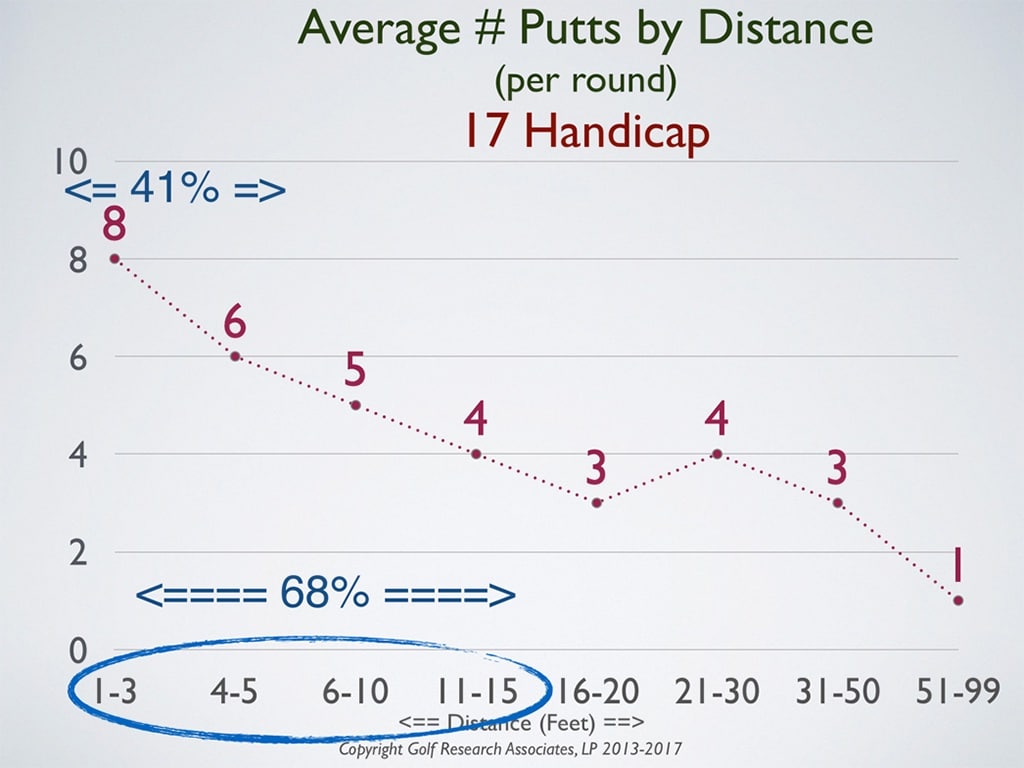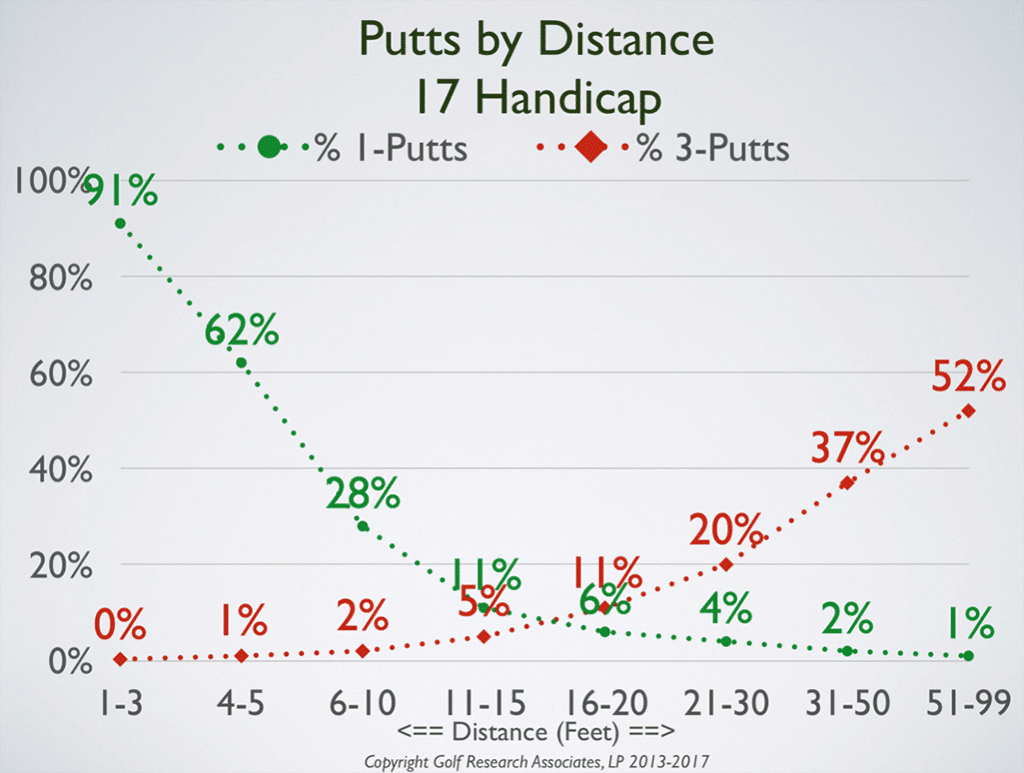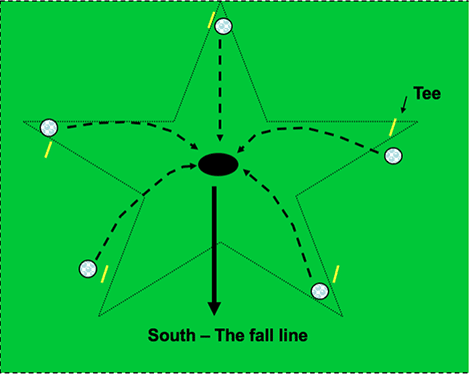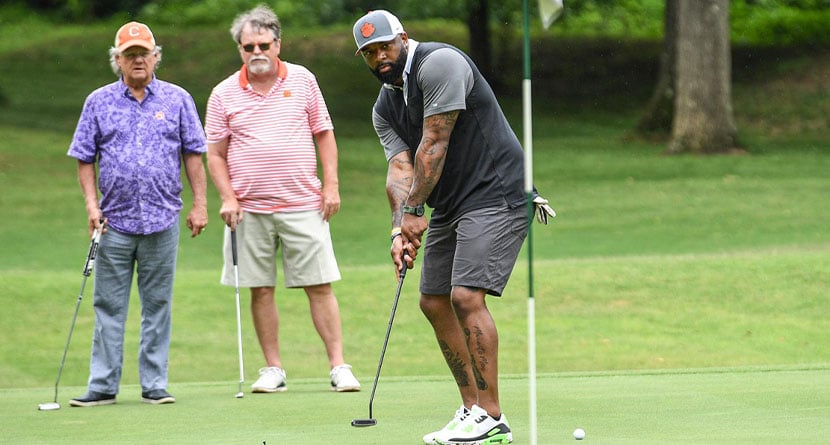If you guessed short putts, you’re a winner.
The often-overlooked fact is that putting is a critical 40% of the game. This is true of all golfers at every level.
The average PGA Tour player needed 29 putts to shoot an average score of 70.6 (41% of strokes). The average 17-handicap golfer needs 34 putts to achieve their average score of 89 (or 38%). This number would be greater than 40% of average golfers putted everything out.
Clearly, not many of us have the physical skill to drive the ball like a Tour player, but almost anyone can putt like a Tour player with the right equipment, technique and practice. There’s been a lot written about equipment and techniques for better putting. What’s surprisingly not talked about as much is an approach for practicing this all-important skill.
For guidance, I studied our database recorded at a 17-slope adjusted differential (this was the 12,000+ rounds we have for golfers that actually played exactly to their 17-handicap). The data shows us that a 17-handicap male golfer’s average round includes:
Long Game
- 5.3 greens in regulation with an average putting distance of 27 feet.
Short Game (shots within 50 yards of the hole):
- 9 chip/pitch shots, of which 7 successfully hit the green to an average putting distance of 15 feet. The other two are errors or missed greens.
- 2 sand shots. When Mr. 17 successfully hits the green, which is only 65% of his sand attempts, his average putting distance is 18 feet.
Putting:
- 34 total putts, including:
- 1-Putts = 3.2
- 2-Putts = 11.8
- 3-Putts = 2.3
- 4-Putts = once every 20 rounds.
50% Make Distance: The distance from which our prototype will make 50% of putts is 5 feet. (By comparison, the PGA Tour player’s 50% make distance is 8 feet.)
2-Putt Range: The distance from which the prototype average will 2 putts is 16 feet. This means that outside of 16 feet, our 17-handicapper will 3-putt with a greater frequency than 1-putt. (The PGA Tour’s 2.0 distance is 34 feet.)
I used our data to project recommended practice distances. As you can see below, 68% of the average golfer’s putting opportunities are from 15 feet and closer and 41% are from 5 feet and in.

The chart below displays our average 17-handicapper’s 1-putt and 3-putt percentages by distance range.

Finally, I charted 1-putt percentages from 3-10 feet for the average 17- and 10-handicap golfer.

Practice Recommendations
- How much time to devote? Putting is worth 40% of whatever amount of time you spend practicing golf.
- 70% of your practice putting time should be devoted to increasing your 1-putt percentages on short putts and expanding your 50% make distance.
- 30% of your putting practice time should be spent improving your distance control on lag putts in the 20-50 foot ranges and extending your two-putt distance.
The “Star Drill”
I was taught this practice drill by a young professional over 30 years ago, and if you follow the Tour, you will see players using a version of this while warming up.
Place 5 tees a given distance from the hole in a star pattern. I recommend starting with 3 feet. A slight slope will provide a slope from each direction as shown below.
After a warmup, work around the star twice and see how many you can make of the ten attempts. When you can make 9 of 10 from 3 feet, move the tees to 4 feet. When you can make 7 or 8 of 10 from 4 feet move to five feet.
Make sure to practice your set-up routine with each putt and make it real.

Distance Control: Lag Putts
Place a tee 20 feet from a target or hole. Use two or three balls and practice lagging them back and forth until you can consistently get the balls to the target, but no farther than 2 feet past the hole.
Repeat the drill from 30 and 40 feet trying to leave the putts no farther than 3 feet from the target.




